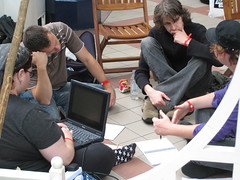I’ve stopped blogging over the last several weeks as I uprooted my family and moved to London to start my new job. But there have been some interesting things worth tracking recently I thought I might mention.
(Interestingly, Twitter usurped any blogging impulses I’ve had during the transition, but it’s time to get back into the long form dialog a little again now that we’re settling in here.)
First, I’m really pleased to see Yahoo!’s open strategy taking shape with things like SearchMonkey, Glue, and the forward-looking presentations done at Web 2.0 Expo. In my opinion, they are still underestimating the power of what Yahoo! could be doing by opening outwardly more, but the momentum is definitely in the right direction regardless of the distracting M&A discussions.
Second, I love where Umair Haque is going with his ‘Good vs Evil’ strategic thinking stuff. He’s getting into why the costs of evil are starting to outweigh the benefits in a globally networked and highly elastic economic landscape.
“As Starbucks and Wal-Mart are discovering, orthodox strategy was built for an industrial world – an equilibrium world of oligopolies, soulless “product”, and zombified “consumers”. But that’s not today’s world.”
Even better than his post, perhaps, is the comment stream which includes this insight from Mike Bonifer who compares today’s competitive landscape to the art of improvisation:
“What many do-gooders fail to acknowledge is that it is not enough to do good. One must also confront, then work artfully at marginalizing, out-witting, out-designing and out-performing the forces of evil that are afoot in the world. Forces like greed, hate, terror, racism, misunderstanding, obfuscation and fear. Heroism is only as strong as the calumny it overcomes.”
Third, I loved hearing the meaty thinking going on in the heads of Lucas Gonze and Jon Udell talking on IT Conversations. It’s as if they are both articulating Clay Shirky’s cognitive surplus view of the world through a music lens:
“Imagine that we lived in a world where all photography was the kind you see in magazines. In this world all photos are taken by professionals and all the people who got their pictures taken are models at the peak of their career. If you had your picture taken normally, you’d think you were hideously ugly. That is the musical world we grew up in, and it’s bogus. Things don’t have to be that way.”
Jon naturally moved the conversation to the problem of discoverability that has been increasingly difficult to deal with as more and more data builds out across the network. He notes some of the challenges as a consumer of interesting things and as someone who has something interesting to offer. He thinks the answer is a bit higher level than traditional syndication:
“There’s a way of publishing that allows something to flow on the network retaining its full fidelity and usability in other contexts.”
Lastly, the open data services space is getting really really interesting now as context and relevance find their way into the mix. For example, the Dash GPS formally rolled out their open service. And then a Guardian colleague pointed me to the AMEE service (“Avoiding Mass Extinctions Engine”) which finds itself being used on Dopplr and the the current Radiohead tour web site (click on ‘Carbon Calculator’).
There are tons of interesting developments unfolding, and I’m seeing all this stuff through fresh eyes again…one of the great benefits of changing jobs. I’ll do my best to keep the blogging energy up and to provide some analysis. Though I’m sure my perspective will shift a bit…to what, I really don’t know, yet.



